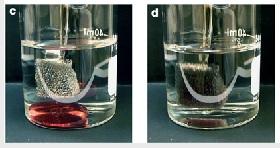Using AI to control energy for indoor agriculture
30 September 2024
Published online 11 March 2012

Inspired by the ability of fish to repel oil in polluted waters, researchers have engineered a surface with an affinity for both oil and water, two immiscible phases, when submerged in water. Such a material would work well in soaking up oil spills in oceans as well as controlling cell and protein adhesion.
The researchers at the Water Desalination Reuse Center at King Abdullah University of Science and Technology (KAUST) in Thuwal, Saudi Arabia, used a silica suspension to deposit silica nanoparticles to a non-woven textile surface, thereby increasing its wetting capability.
They then grafted blocks of a copolymer comprising pH-responsive poly(2-vinylpyridine) (P2VP) and oleophilic polydimethylsiloxane (PDMS) onto the fabric. The PDMS block exhibits a high affinity to oil phases and low affinity to aqueous ones, while the P2VP changes its wettability but also its shape through protonation, depending on the acidity of the aqueous phase.
When the material is submerged in an acidic mixture (pH 2.0), the P2VP chains gain an extra proton and extend outwards. Once extended, they dominate the surface and attract water. Whereas, in low-acidity mixtures (pH 6.5) the P2VP chains lose their extra proton, retract, and expose blocks of PDMS,which attracts oil and repels water, switching the surface's affinity.
The researchers also demonstrated how other, inexpensive and widely available materials might be used. Using the same technique, they turned an artificial sponge into a switchable surface, soaking up oil from one mixture and releasing it in another.
At the ocean's approximate pH of 8.14, the material can suck up oil spills which can then be released elsewhere in an acidic solution to clean oil spills
"We haven't tested the materials' performance for separating crude oil from water, but believe they should be effective," says Peng Wang, a co-author of the paper. They are trying to reach out to potential industrial partners to license this technology.
doi:10.1038/nmiddleeast.2012.31
Stay connected: